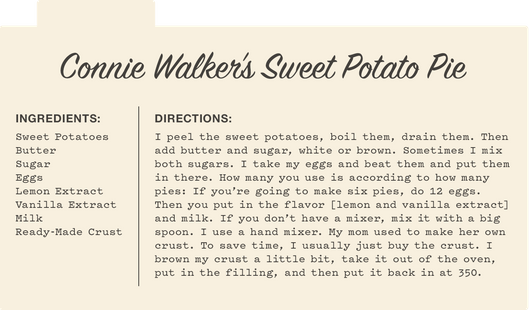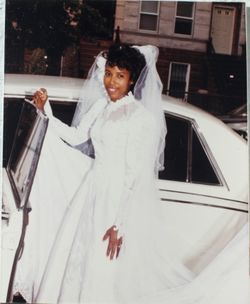Meet the Residents of MacDonough Street
Christine Toes Muldoon sold her house for $1.4 million.<br /><br />
“Some of the blacks were saying, ‘I don’t want Ms. Walker selling her house to these white people.’”
—Connie WalkerTap to see price history of home
Connie Walker, 80Former Tennant, Retired Funeral Director
Now lives in: An apartment around the corner, on Decatur Avenue.
History: Lived on the block for more than 50 years and in this house since 1970. Her daughter Fay bought the house in 2004 and sold it in 2007 for $750,000.
I grew up in Orangeburg, South Carolina. My father was a sharecropper. I enjoyed it because that was our life. That’s all we knew to do. I was born in the country, and we were surrounded by white people. There was good white people, and there were bad white people. I have a lot of white cousins because my family was scared, and the black women had to do that. They had to give it to them. There’s a whole lot to say about living down south.
My momma used to cook for these white people—she used to wash their clothes and iron ’em. So that’s all we knew: working for white people. I get along with them; I like white people. My skin is different from yours, yours is different from mine, but we all God’s children. Ain’t no difference. As soon as black people and white people come to that understanding, they’ll get along more better.
I moved to New York City on my own. I wanted to get out of South Carolina, out of that hot cotton field, but I didn’t know where I wanted to go. I got on Amtrak and came all the way from Columbia, South Carolina, to Penn Station. I lived on MacDonough Street for 50-something years. I guess I was about 19. I was in the beauty parlor around the corner, and this lady said she had a room. When she finished my hair she said, “Come to my house. You’ll see if you like it.” And I did. I lived with them maybe 30 years, I don’t know. They became like my parents. They just took me into their home and raised me up. It was wonderful. They’re all dead now.

I got used to living here. MacDonough Street will always be my block. I am the oldest person on that block now, you know. I know everything about that block. There’s no one that’s living on that block now that you could talk to that would know the things I know about that block.
When I first moved there, there weren’t any blacks. It was all whites, and they sold it to the blacks. And now the blacks are selling it to the whites. I was used to white people, of course, but when I moved here I got to know a lot of white people. My best girlfriend here, Miriam, she lived next door to me. She was a real-estate broker. She and I was very close. She used to tell everyone I was her black mama. I don’t care where we went—to Junior’s to eat, wherever—she said, “This is my black mother. Be nice to her.” And whenever the blacks starting selling their houses on MacDonough Street, I would tell Miriam. And she sold about seven or eight houses. The blacks were selling them and the whites were buying them ’cause they’re the ones who had the money.
I was a funeral director. Ever since my father died, I wanted to know what happened to the dead, what they did to them. So I became a, well, we call it a funeral director, but a mortician, an undertaker, something like that. I did that for years. A lot of people, when someone dies, they get all torn up and upset. So I always liked talking to them. I’d say, “This is the way it has to be. God giveth and he taketh.” A lot of people, young guys, got killed from the drugs, and the parents wanted to know why. “Oh, my child was a good child,” and this and that. Well, they could have been good, but then they was doing the wrong thing. Some of them were coming into the funeral home, and I was saying, “Oh, I’m so sorry about your son. And they’d say, “Miss, don’t be sorry. He wasn’t no good. Don’t feel bad. I don’t have to worry about them no more.” It was a burden for them, these bad kids running out here, and they won’t work, they stealing and killing people, snatching people’s pocketbooks.

My son, every day God sends, he’s around on that block. It’s hard to pull him away from his friends. That’s their headquarters. They sit on the stoop having fun, doing what they do. My son don’t know nothing about nothing else except MacDonough Street. I know Gregory ain’t perfect, but he’s a good person. He’s smart and everything. He helped all of them around there that didn’t have an education.
When we sold our house, some of the blacks were saying, “I don’t want Ms. Walker selling her house to these white people.” We weren’t the first ones who were selling it, but we was close. When we had house openings, blacks came, but if you can’t afford it then you can’t afford it. You sell your property to whomever you can get your money from.
When I moved, it was a little hard. But what I did was I prayed, and I didn’t go back around there for a couple of months. And when I went back ’round there, they all came out to hug and kiss me. And they still do it right now. Sometimes I still forget I’m not around there. I don’t know nobody here. I mean I speak to people here, but I don’t know nobody.
Christine Toes Muldoon, 38Former Owner, Real-Estate Agent
Lives with: Her husband, Phil, and their son, Shea.
Moved from: West Village
Now lives in: Carroll Gardens
My money would have purchased a one-bedroom condo in Manhattan or a two-family, three-story townhouse in Bed-Stuy. When I saw the house I ended up buying, it was really run-down. You had to have vision to buy something like that. When I bought the place, I thought that at some point I might live there. But I had no idea when that some point might be. If my husband had been there—we weren’t married at the time—there’s no way he would have done it. He would have said I was crazy.
In 2010, we moved to the house from my 520-square-foot one-bedroom. I had done a pretty major renovation when I purchased it, but my renters didn’t take very good care of it. They had planted some vegetables in the backyard, but kind of in a mishmash fashion. So you couldn’t really tell what was weeds and what was vegetables. Apparently they had contemplated putting chickens back there, and one of my neighbors was like, “You’re absolutely not putting chickens in the backyard.” I had a total of maybe five people signed between the two leases. There had to have been 10 people living there. A room that was intended to be a living room was being used as a bedroom. There were kind of random curtain dividers. There were some strange paint-color selections—bright green, red.
I’d grown up in New York City in the ’80s, in Stuy Town. The 14th Street side of the complex between Avenue D and First Avenue was dangerous. My parents had lived on 9th and A in the ’70s. They could have bought their entire building for $30,000. When I tell them that, they say, “But honey, there were hypodermic needles in the street!” I think probably the fact of my parents having not bought that building affected the way I was thinking about my investment. Because when I was in Bed-Stuy, I thought, There is so much potential in this neighborhood. I mean, take Park Slope. My friends who grew up in Park Slope in the ’80s had their cars stolen and vandalized many times. Fort Greene was not the greatest place 20 years ago either. But still, in 2007, when you went past a certain point in this neighborhood, there were still boarded-up houses. People didn’t take care of their front yards. There was trash. But MacDonough between Malcolm X and Patchen was always a gorgeous block. People had lived there for a really long time.
Once he got settled, my husband really liked how everyone took care of their houses. He really liked our neighbors. He started shoveling Ms. Lorde’s snow. And then she baked us a cake and knitted us a baby blanket and a hat when our son Shea was born. There’s a group of guys who hang out on the stoop diagonally from our house. When I first bought the house, I was like, Who are these guys hanging out over here? I was sort of nervous about it. But then once I met them and saw how friendly they were, I was actually very comforted that they were there. It was almost like they were the neighborhood watch. I felt like they had my back. They’re hilarious. When Shea was born they were like, “Come over and have a drink with us!” Of course, one drink turned into I don’t know how many.
In 2013, our house was on the house tour, which was kind of one of my dreams from when I started thinking about buying in the neighborhood. I think showing off the neighborhood and how beautiful the housing is to people who aren’t necessarily from the neighborhood—I think that’s important.